
Candice Chirwa: 'Menstruation is More than Just Bleeding for Seven Days.'
Image supplied by Candice Chirwa.
SEARCH

Candice Chirwa: 'Menstruation is More than Just Bleeding for Seven Days.'
South African activist Candice Chirwa, the 'Minister of Menstruation', speaks to us about what a period-positive world looks like, the challenges menstruators face even in 2020 and her important advocacy work with QRATE.